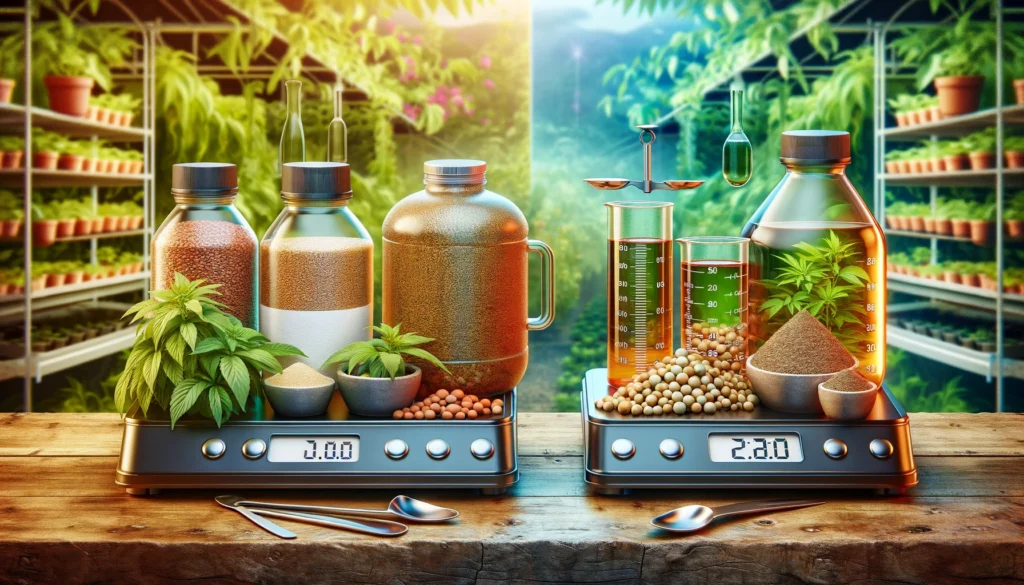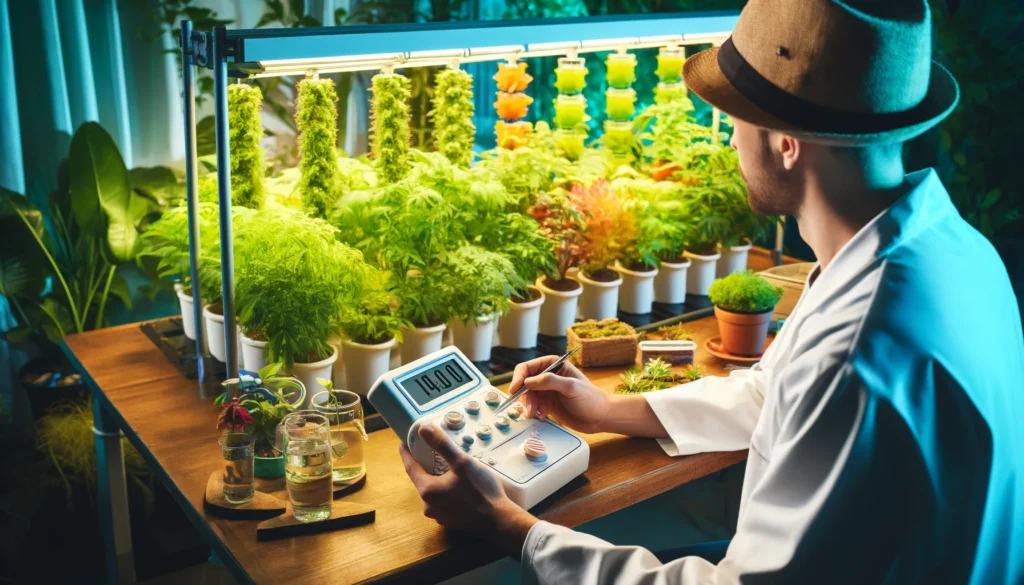Welcome, home gardeners! If you’re diving into hydroponics, one of the most critical decisions you’ll make is selecting the right nutrients for your plants. Nutrients come in two primary forms: dry and liquid. Each type has its pros and cons, and understanding these can help you make an informed decision to optimize your garden’s growth. This in-depth guide will cover everything you need to know about dry and liquid nutrients for hydroponics.
Understanding Hydroponic Nutrients
Before we delve into the comparison, let’s briefly cover the basics of hydroponic nutrients. Plants need essential nutrients to grow, which are usually divided into macronutrients and micronutrients.
Macronutrients
- Nitrogen (N): Promotes leafy growth.
- Phosphorus (P): Supports root development and flowering.
- Potassium (K): Aids in overall plant health and disease resistance.
Micronutrients
- Calcium (Ca), Magnesium (Mg), Sulfur (S): Essential for various plant processes.
- Trace Elements: Includes iron (Fe), manganese (Mn), zinc (Zn), copper (Cu), molybdenum (Mo), and boron (B).
Hydroponic nutrient solutions must provide a balanced mix of these elements to ensure optimal plant health and productivity.

Dry Nutrients
Dry nutrients are available in powder or crystalline form and need to be dissolved in water before use.
Advantages of Dry Nutrients
- Cost-Effective: Dry nutrients are generally cheaper per volume compared to liquid nutrients.
- Long Shelf Life: They have a longer shelf life as they don’t contain water, which can cause degradation over time.
- Customizable: You can mix and match different dry nutrients to create custom blends tailored to your specific plant needs.
- Bulk Storage: Easier to store in bulk without taking up too much space.
Disadvantages of Dry Nutrients
- Preparation Time: Requires additional time to measure, mix, and dissolve the nutrients properly.
- Mixing Errors: There’s a higher chance of making errors in mixing the correct ratios.
- Not Always Soluble: Some dry nutrients may not dissolve completely, leading to clogging issues in your hydroponic system.
Using Dry Nutrients
- Measure Accurately: Use a digital scale to measure the nutrients precisely.
- Mix Thoroughly: Dissolve the nutrients in a small amount of warm water before adding them to your reservoir.
- Stir Well: Ensure the nutrient solution is well-mixed to prevent sedimentation.
Best Practices for Dry Nutrients
- Pre-Mix: Prepare concentrated solutions in advance to save time.
- Label Clearly: Always label your pre-mixed solutions to avoid confusion.
- Store Properly: Keep the dry nutrients in a cool, dry place to extend their shelf life.
Liquid Nutrients
Liquid nutrients are pre-mixed solutions that are ready to use, making them very convenient.
Advantages of Liquid Nutrients
- Ease of Use: They are pre-mixed, so you can use them straight from the bottle without additional preparation.
- Consistency: Ensures consistent nutrient ratios in every use, reducing the risk of mixing errors.
- Quick Absorption: Nutrients are readily available for plant uptake, promoting faster growth.
- Convenience: Ideal for beginners and those with limited time for garden maintenance.
Disadvantages of Liquid Nutrients
- Higher Cost: Typically more expensive than dry nutrients due to added water weight and shipping costs.
- Shorter Shelf Life: Can degrade faster once opened, especially if not stored properly.
- Bulk Storage: Requires more storage space, especially for larger gardens.
- Potential for Contamination: More susceptible to contamination and microbial growth if not handled properly.
Using Liquid Nutrients
- Shake Well: Always shake the bottle before use to ensure even distribution of nutrients.
- Measure Precisely: Use measuring tools like graduated cylinders or syringes to get the right amount.
- Dilute Correctly: Follow the manufacturer’s instructions for dilution ratios to avoid over-fertilizing.
Best Practices for Liquid Nutrients
- Store in a Cool, Dark Place: To prolong shelf life and maintain potency.
- Avoid Contamination: Use clean measuring tools and avoid touching the inside of the bottle.
- Regular Checks: Monitor the nutrient solution regularly for signs of spoilage or sedimentation.

Comparing Dry and Liquid Nutrients
| Feature | Dry Nutrients | Liquid Nutrients |
|---|---|---|
| Cost | Generally cheaper per use | Generally more expensive per use |
| Shelf Life | Longer, more stable | Shorter, especially once opened |
| Ease of Use | Requires mixing | Ready-to-use |
| Customizability | Can customize blends | Pre-mixed, less customization |
| Storage | Lighter, takes up less space | Bulkier, heavier |
| Precision | Requires careful measurement and mixing | Consistent pre-mixed formula |
Cost
- Dry Nutrients: Generally more cost-effective, especially for larger setups.
- Liquid Nutrients: More expensive due to added water weight and convenience.
Convenience
- Dry Nutrients: Requires mixing and preparation, which can be time-consuming.
- Liquid Nutrients: Ready to use, saving time and reducing preparation errors.
Storage and Shelf Life
- Dry Nutrients: Longer shelf life and easier bulk storage.
- Liquid Nutrients: Shorter shelf life and requires more storage space.
Customization
- Dry Nutrients: Easier to customize for specific plant needs.
- Liquid Nutrients: Limited customization options but provides consistent nutrient ratios.
Usage
- Dry Nutrients: Suitable for experienced gardeners who can accurately measure and mix.
- Liquid Nutrients: Ideal for beginners and those looking for a hassle-free solution.
Case Study: Real-World Application
To better illustrate the differences, let’s look at a real-world example:
Home Gardener A prefers liquid nutrients for their small indoor hydroponic system. They enjoy the convenience and consistency, despite the higher cost. The ready-to-use aspect of liquid nutrients fits their busy lifestyle, allowing them to maintain their garden with minimal effort.
Home Gardener B uses dry nutrients for their larger outdoor hydroponic setup. They appreciate the cost savings and longer shelf life. Although it requires more effort to mix the nutrients, they find the customization aspect beneficial for tailoring the nutrient solution to different plant species.
Choosing the Right Nutrient Type for Your Garden
Factors to Consider
- Garden Size: Larger gardens may benefit from the cost-effectiveness of dry nutrients, while smaller setups might prefer the convenience of liquid nutrients.
- Experience Level: Beginners might find liquid nutrients easier to use, while experienced gardeners can take advantage of the customization offered by dry nutrients.
- Budget: Consider your budget for initial setup and ongoing maintenance. Dry nutrients are typically cheaper, but liquid nutrients save time and effort.
- Time: If you have limited time for garden maintenance, liquid nutrients can be a better choice.
Making the Switch
If you’re currently using one type of nutrient and considering a switch, here’s how you can transition smoothly:
- Test Small: Start with a small batch of the new nutrient type to see how your plants respond.
- Monitor Closely: Pay close attention to your plants’ health and growth during the transition.
- Adjust Gradually: Gradually phase out the old nutrient type while introducing the new one to avoid shock to your plants.

Tips for Optimal Nutrient Management
Regardless of whether you choose dry or liquid nutrients, here are some tips to ensure your plants get the best care:
Regular Monitoring
- pH Levels: Keep the nutrient solution’s pH between 5.5 and 6.5 for optimal nutrient uptake.
- EC/TDS Levels: Measure the electrical conductivity (EC) or total dissolved solids (TDS) to ensure nutrient concentration is within the recommended range.
Clean System
- Prevent Clogging: Regularly clean your hydroponic system to prevent clogging, especially when using dry nutrients.
- Change Solutions: Replace the nutrient solution every two to three weeks to prevent nutrient imbalances and buildup.
Plant-Specific Needs
- Tailored Nutrients: Adjust nutrient formulas based on the specific needs of your plants. For example, flowering plants may require more phosphorus.
- Stage-Specific Feeding: Different growth stages (seedling, vegetative, flowering) have different nutrient requirements. Adjust accordingly.
Environmental Factors
- Light: Ensure your plants receive adequate light, whether natural or artificial.
- Temperature and Humidity: Maintain optimal temperature and humidity levels to support healthy growth.
Conclusion
Choosing between dry and liquid nutrients for your hydroponic garden ultimately depends on your specific needs, preferences, and circumstances. Dry nutrients offer cost savings and customization, while liquid nutrients provide convenience and consistency. By understanding the pros and cons of each type, you can make an informed decision that will help your garden thrive.
Remember, the key to successful hydroponic gardening lies in providing your plants with the right nutrients, maintaining a clean and well-functioning system, and regularly monitoring and adjusting the environment. Whether you opt for dry or liquid nutrients, your plants will reward you with bountiful, healthy growth.
We’d love to hear about your hydroponics journey! Are you Team Dry or Team Liquid? Share your experiences, tips, and success stories with us. Join our community for weekly tips, tricks, and support from fellow hydroponics enthusiasts. Sign up for our newsletter, and let’s grow together!
Remember, there’s no right or wrong choice—just what works best for you and your garden. So let’s get those green thumbs working and make our hydroponics garden the envy of the neighborhood!
Feel free to drop a comment or question below, and let’s keep this gardening conversation going. Happy growing, friends!
Related Products…
-
Product on sale
%22%20transform%3D%22translate(.6%20.6)%20scale(1.17188)%22%20fill-opacity%3D%22.5%22%3E%3Cellipse%20fill%3D%22%23b4c26f%22%20rx%3D%221%22%20ry%3D%221%22%20transform%3D%22matrix(151.8424%20-.37345%20.13706%2055.72602%20176.8%20137)%22%2F%3E%3Cellipse%20fill%3D%22%23efecfe%22%20rx%3D%221%22%20ry%3D%221%22%20transform%3D%22rotate(-171%2070.4%203.6)%20scale(232.67047%2045.54361)%22%2F%3E%3Cellipse%20fill%3D%22%23f3f0ff%22%20rx%3D%221%22%20ry%3D%221%22%20transform%3D%22matrix(65.06015%20-8.28077%204.2839%2033.6576%20210.3%20231)%22%2F%3E%3Cellipse%20fill%3D%22%23bab7c9%22%20cx%3D%22125%22%20cy%3D%22147%22%20rx%3D%2225%22%20ry%3D%22129%22%2F%3E%3C%2Fg%3E%3C%2Fsvg%3E) Humboldts Secret Liquid Hydroponics Fertilizer Set A&B – Top Nutrient System for Hydroponic Growth – Ideal for Indoor and Outdoor Plants – Promotes Growth during Vegetative and…Original price was: $44.97.$31.98Current price is: $31.98.
Humboldts Secret Liquid Hydroponics Fertilizer Set A&B – Top Nutrient System for Hydroponic Growth – Ideal for Indoor and Outdoor Plants – Promotes Growth during Vegetative and…Original price was: $44.97.$31.98Current price is: $31.98. -
%27%20fill-opacity%3D%27.5%27%3E%3Cpath%20fill%3D%22%23f8f5ff%22%20fill-opacity%3D%22.5%22%20d%3D%22M343.4%20113v187.6h-88V113z%22%2F%3E%3Cellipse%20fill%3D%22%23000005%22%20fill-opacity%3D%22.5%22%20rx%3D%221%22%20ry%3D%221%22%20transform%3D%22matrix(4.87453%20-59.9926%20284.9041%2023.14908%2082%208.5)%22%2F%3E%3Cellipse%20fill%3D%22%23f1f3e0%22%20fill-opacity%3D%22.5%22%20rx%3D%221%22%20ry%3D%221%22%20transform%3D%22matrix(-23.73813%20113.62803%20-50.24658%20-10.49706%201%20239.2)%22%2F%3E%3Cellipse%20fill%3D%22%23889a27%22%20fill-opacity%3D%22.5%22%20rx%3D%221%22%20ry%3D%221%22%20transform%3D%22matrix(-64.78446%20-53.49559%2030.51057%20-36.94904%2094.2%20194.5)%22%2F%3E%3C%2Fg%3E%3C%2Fsvg%3E) 2.2 lb General Hydroponics MaxiGro Plant Food Promotes Vigorous Growth$15.99
2.2 lb General Hydroponics MaxiGro Plant Food Promotes Vigorous Growth$15.99 -
Product on sale
%27%20fill-opacity%3D%27.5%27%3E%3Cellipse%20fill%3D%22%23e3cde9%22%20fill-opacity%3D%22.5%22%20rx%3D%221%22%20ry%3D%221%22%20transform%3D%22rotate(170.2%2041.8%2017.4)%20scale(298.82813%2042.59001)%22%2F%3E%3Cellipse%20fill%3D%22%234ea41b%22%20fill-opacity%3D%22.5%22%20rx%3D%221%22%20ry%3D%221%22%20transform%3D%22matrix(-69.90753%201.82387%20-4.33172%20-166.03164%20270.4%20218)%22%2F%3E%3Cellipse%20fill%3D%22%23c2417b%22%20fill-opacity%3D%22.5%22%20rx%3D%221%22%20ry%3D%221%22%20transform%3D%22matrix(-58.94836%20-.01314%20.04946%20-221.91372%2039.4%20260.6)%22%2F%3E%3Cellipse%20fill%3D%22%23383f50%22%20fill-opacity%3D%22.5%22%20rx%3D%221%22%20ry%3D%221%22%20transform%3D%22matrix(-26.1675%20-.27404%201.09104%20-104.18296%20145.9%20247.8)%22%2F%3E%3C%2Fg%3E%3C%2Fsvg%3E) Trial Pack of General Hydroponics FloraSeries Hydroponic Nutrient Fertilizer System – Includes FloraMicro, FloraBloom, and FloraGro, 1 qtOriginal price was: $36.99.$34.40Current price is: $34.40.
Trial Pack of General Hydroponics FloraSeries Hydroponic Nutrient Fertilizer System – Includes FloraMicro, FloraBloom, and FloraGro, 1 qtOriginal price was: $36.99.$34.40Current price is: $34.40.
Forum
Got something to share or a question to ask? Jump in and start a conversation! Whether it’s tips, advice, or just sharing your experiences, we’d love to hear from you. Don’t be shy—your input could inspire or help someone else!- This forum has 1 topic, and was last updated 10 months, 2 weeks ago by .
- Topic
- Voices
- Last Post
- You must be logged in to create new topics.






